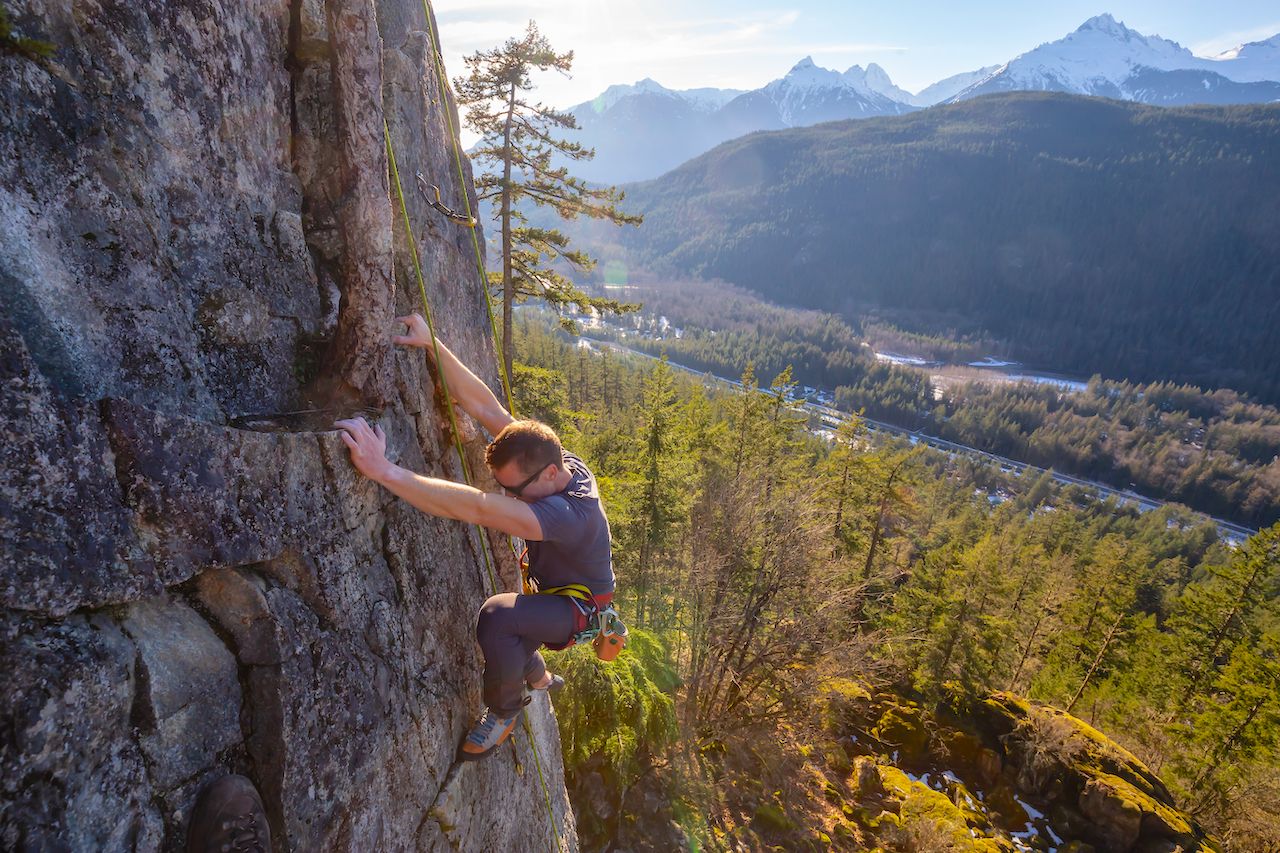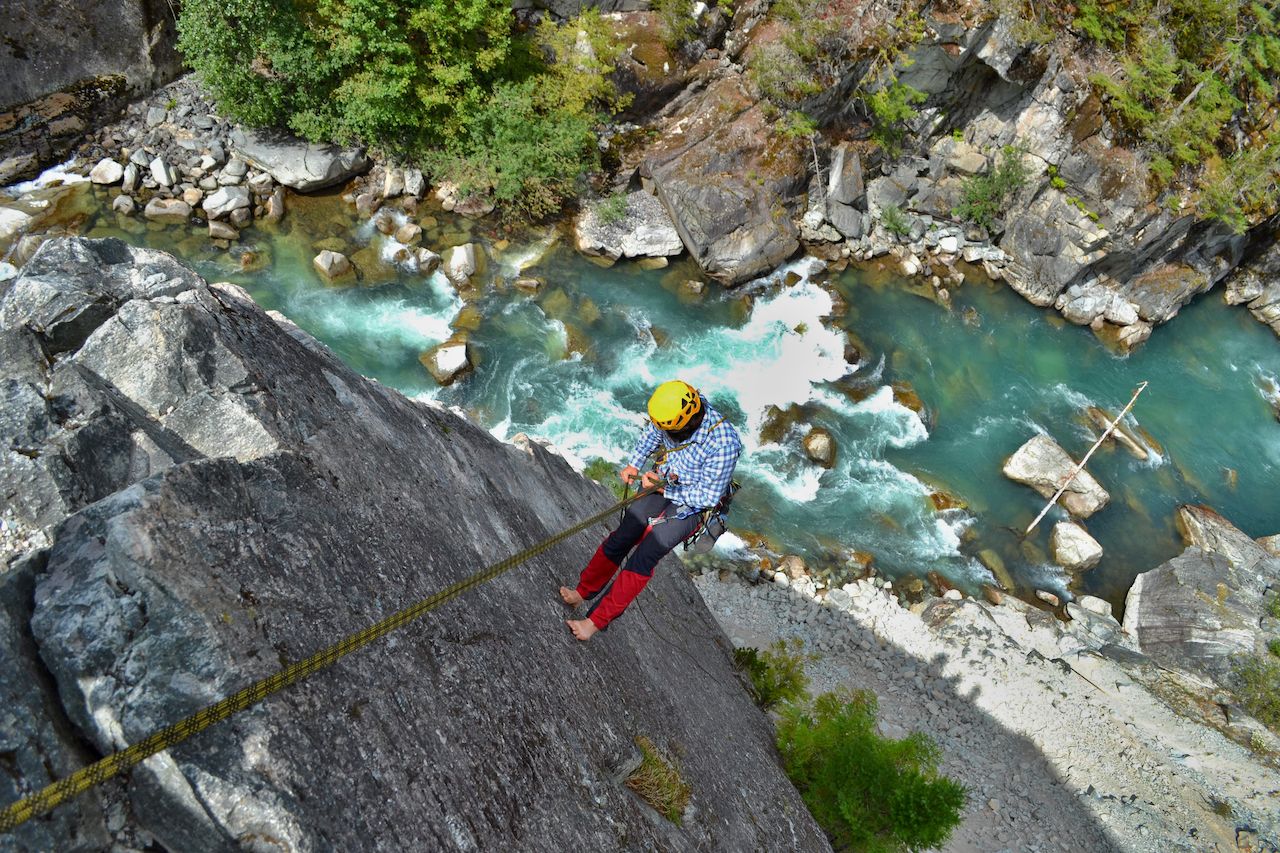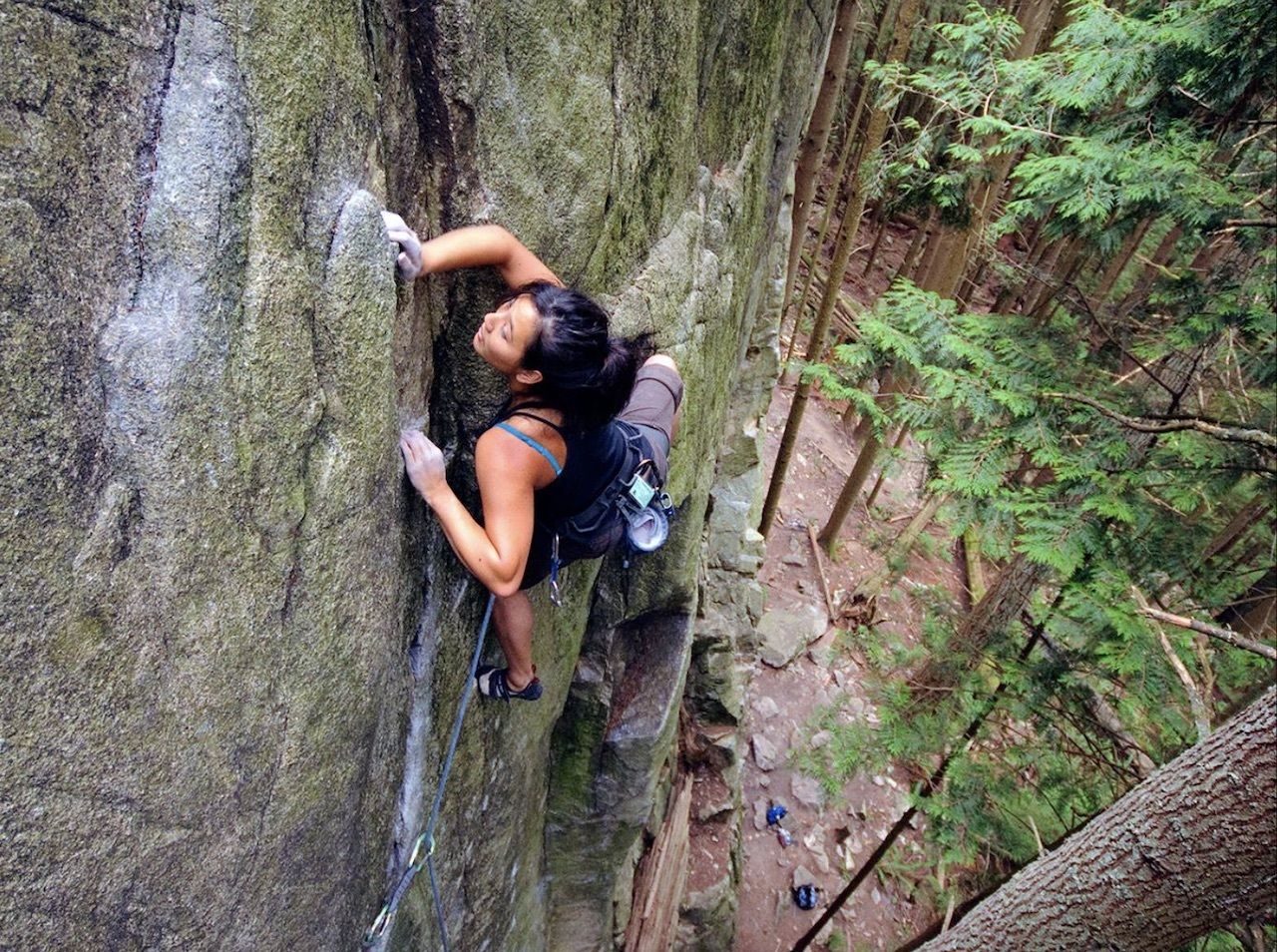British Columbia, Canada, is home to some of the best rock climbing in North America — with granite faces that rival the best climbing in California’s Eastern Sierras. A bonus is that these are much easier to reach, as they are just outside the major metropolis of Vancouver. Whether you visit the North Shore Mountain crags on a coastal inlet just a bridge away from downtown or head an hour north of Vancouver to well-developed climbing areas in Squamish, you’ll find everything from beginner-friendly to elite world-class options. Here’s your guide to the best British Columbia climbing.

British Columbia’s Rock Climbing Is as Intense and Exciting as the Sport Gets
Sport Climb with a View in Area 44 in Squamish

Photo: EB Adventure Photography/Shutterstock
Area 44 is one of the best beginner to intermediate sport climbing areas along the Sea-to-Sky Highway. The 40-mile drive to the crag north of Vancouver, past the coastal community of Squamish, and along the winding mountain road with vistas over the Pacific Ocean is an adventure in its own right.
Park along the Swift Creek Forest Service Road just off the highway located on the right-hand side right after Brohm Lake when traveling north. To get to the trailhead for Area 44, cross the highway and walk along a dirt path next to the concrete barrier. Take the footpath downhill through the bushes, and soon you will arrive at the signs welcoming you to the climbing area.
Area 44 is extremely well-developed. You will find hand-made wooden directional signage in the forest and laminated descriptions of all routes with their locations, grades, and the number of quickdraws required. The approach from the parking lot is less than 15 minutes.
You will find just over 40 bolted routes in the area with a grade range from 5.6 to 5.11c. Most of the climbs are about 100 feet tall. The granite has many small edges in flakes and is very comfortable to climb on. Consider trying the 5.10b route called Rocky Horror, which made the shortlist of 100 best climbs around Squamish.
The crag looks over the fantastic Tantalus Range, snow-capped even during the hot summer months. After your climb, drive further north along the Sea-to-Sky Highway to the Tantalus Lookout, from which you can see the mountains and the river along the valley all the way back to Squamish. On your drive back, consider stopping for food and drink at one of the breweries in Squamish.
Sport Climb in Cheakamus Canyon in Squamish

Photo: Annari/Shutterstock
Located further north past Area 44 on the Sea-to-Sky Highway, Cheakamus Canyon is Vancouver’s largest sport climbing area. The crag features some of the hardest sport climbs in Canada but has plenty of routes in the 5.8-5.10a range that beginner and intermediate climbers will enjoy. Some of the favorite climbs in the area are Emil and the Detectives (5.8) and Charlotte’s Web (5.9).
The best thing about the crag is the convenient approach right from the parking lot. To get to the parking lot, look for a bend on the right-hand side when traveling north on Sea-to-Sky just over a mile past the orange highway bridge over the Culliton Creek. Turn right on Conroy Forest Road and park in the pullout on the right-hand side. Since Cheakamus Canyon is only 20 miles away from Whistler, plan to end your day with a visit to Brandywine Falls and a nice dinner in Whistler Village.
Climb the Chief in Squamish

Photo: 2009fotofriends/Shutterstock
The granite monolith Stawamus Chief, or the Chief, is to British Columbia climbing enthusiasts what El Capitan in Yosemite is for folks south of the border. Most of the climbs on the Chief are suitable for traditional climbing, where a climber ascends along routes that have not been bolted and places gear directly into cracks and other features of the rock. The several bolted sport routes along the Chief are fairly advanced.
However, if you are a novice but would like to experience climbing around Stawamus Chief, you can hire an experienced guide to take you up the rock. Local Squamish providers will work with your climbing skill level and offer individualized experiences for climbing the Chief. Alternatively, explore the vast number of bouldering problems at the foot of the Chief on your own. The boulders are scattered throughout the forest and can be approached from the Stawamus Chief Provincial Park parking lot.
Whether you decide to climb around the Chief or not, the area is worth a visit. Spend some time at one of the picnic tables at the viewing area below the Chief and watch the numerous climbers on the great wall.
Sport climb at Sully’s Hangout in Lynn Headwaters Park in North Vancouver

Photo: Vancouver Rock Climbing/Facebook
Sully’s Hangout is located in the Lynn Headwaters Regional Park, accessible by bus or a short drive from Vancouver. The crag is located in the forest along the shoulder of Lynn Peak, one of the local mountains.
To get to Sully’s from the parking lot, walk across the bridge to the other side of Lynn Creek, turn right, and walk along the gravel Lynn Headwaters Connector path. At the signpost, turn left onto the Lynn Loop trail and climb it uphill to a small unmarked trail on the right-hand side located before the second signpost. The unmarked trail will climb through the woods towards the base of the granite wall with the climbs. The uphill approach will take you about 30 minutes and is a great way to warm up before you climb.
Sully’s Hangout has nine approachable sport climbs ranging from 5.7 to 5.10a; another 16+ climbs range 5.10b-5.12b. The route titled 3M is about 100 feet tall and features an easy 5.8 climb to the mid-pitch anchor, then a 5.10a route to the anchor at the top of the ledge. The area is shaded by large trees and can be enjoyed even in the middle of a summer day. At the end of your climbing day, visit the nearby Lynn Canyon Suspension Bridge for heady views over the Lynn Canyon.
Boulder at Lynn Boulders in Lynn Headwaters Park in North Vancouver

Photo: The Hive Bouldering GymThe Hive Bouldering Gym/Facebook
Lynn Boulders are scattered throughout the forest in the Lynn Headwaters Park in North Vancouver, close to Sully’s Hangout. The boulders feature over 140 problems ranging from V1 to V10. The high density and variety of grades make this an excellent spot for beginners and advanced climbers. You will enjoy the massive boulders, the silence of the old rainforest around you, and the giant first-growth stumps scattered through the woods.
To get to the boulders, turn left after crossing the bridge over Lynn Creek, walk along the gravel Cedar Mills Trail, and turn right at the sign for Lynn Loop Trail. Climb up the switchbacks to the junction and turn right on the Lynn Loop Trail. You will soon come across another junction with a sign for boulders. Follow the footpath until you reach the first granite blocks. The approach should take no more than 30 minutes on foot from the parking lot and is a great warm-up. Refuel afterward with a snack from the End of the Line General Store, which has been serving the community for over 100 years.
Outdoor safety and gear rentals in British Columbia

Photo: Daniel Bruce Lacy/Shutterstock
British Columbia’s land and water habitats have the highest biodiversity in North America. The locals are lucky to live in areas surrounded by a lush rainforest and learn to coexist with various wild species. Deer, black bears, bobcats, and cougars are abundant in the suburbs and smaller towns. Even in the center of Vancouver, you will spot coyotes, bald eagles, owls, and, when looking offshore, sea otters, seals, and sometimes orcas. Peregrine falcons nest on the cliffs of the Stawamus Chief, and local access societies work with climbers to ensure the nesting areas are undisturbed.
You will be entering a wildlife country in all of the climbing areas described above. The best way to prepare is to plan to avoid a wildlife encounter. Educate yourself on basic principles of bear awareness: travel in groups and ensure you can be heard from a distance, bring bear spray and know how to use it, keep your pets on the leash, and don’t leave your food unattended. Also, remember that although you should be prepared to have a run-in with wildlife, it is highly unlikely that you will.
The best guide books for the area are Squamish Select by Marc Bourdon and Vancouver Rock Climbing by Rich Wheater. Both are available in print and ebook format on the publisher’s site; you can also find a hard copy at local outdoor outfitters. For up-to-date information on events and access to crags in Squamish, check the Squamish Access Society home page. Climbing on the North Shore is stewarded by the Vancouver Climbers Association.
Always wear a helmet when sport climbing outdoors. This will protect you from rockfall and the possibility of irresponsible hikers in areas with foot access to the ledge of the crag. In case of an emergency or injury, call 911.
Climb On Equipment and Valhalla Pure Outfitters in Squamish rent climbing shoes, bouldering pads, harnesses, and helmets. Get in touch with the bouldering gym Hive North Shore to rent a bouldering pad in Vancouver.